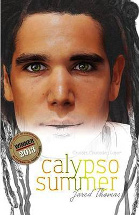Calypso Summer by Jared Thomas

Magabala Books, 2014. ISBN 9781922142122.
(Ages: Mature senior secondary students) Kyle Summer is a young
Nukunu man who lives near Henley Beach in Adelaide. He's known to
all as Calypso because of his dreadlocks, love of Bob Marley
and reggae music and the West Indies cricket team. His Rasta persona
masks his own insecurities. After leaving school and failing to get
his dream job in a sports store, he is at a loss and spends a lot of
time smoking dope and not much else. Then things start to look up,
he ends up with a job in a health food store and really has a knack
for it, gets on well with his boss and starts to turn his life
around. He moves out of home and into a little flat and feels
proudly independent. The blight on this is a cousin, Run, moving in
to bludge. When his boss suggests getting some native bush
remedies to sell as products in the store, Calypso's mother directs
him to his mob in the Southern Flinders Ranges and this urban Indigenous
man begins to develop an affinity with his country and culture.
Ensuing troubles with some less than welcoming cousins, and the
deadbeat Run, who is thieving and dealing dope, result in some major
drama for
Calypso, but the support of his new girlfriend, a smart Ngadjuri girl
who happens to share his passion for cricket, and the newly found
family circle, prove the right medicine for his woes.
Winning the State Library of Queensland award in 2013 Black &
Write competition, Jared Thomas has tried to provide a realistic
view of the struggle for young Indigenous people and their conflicts with
cultures.
Personally I found the novel a bit hard-going at times and found it
difficult to connect with the characters or be sympathetic. I have
Koori and Murri family and friends, have spent years teaching Indigenous
kids, young adults, and adults, and worked in Indigenous units and
while lots of these friends use the word 'deadly' their vocabulary does also
embrace other adjectives. There was a point when I thought if
I read the word 'deadly' one more time I might just scream.
The novel seemed rather heavy-handed in its heaping upon the reader
every conceivable Indigenous issue.
That being said, I believe that young people would relate to it and
non-Indigenous readers would gain some understanding of the
challenges facing Indigenous culture.
The novel is marketed as YA but I would suggest that it is only
suitable for mature senior students. The frequent profanity and
emphasis on drug usage would make me hesitate about making it
generally available.
Sue Warren